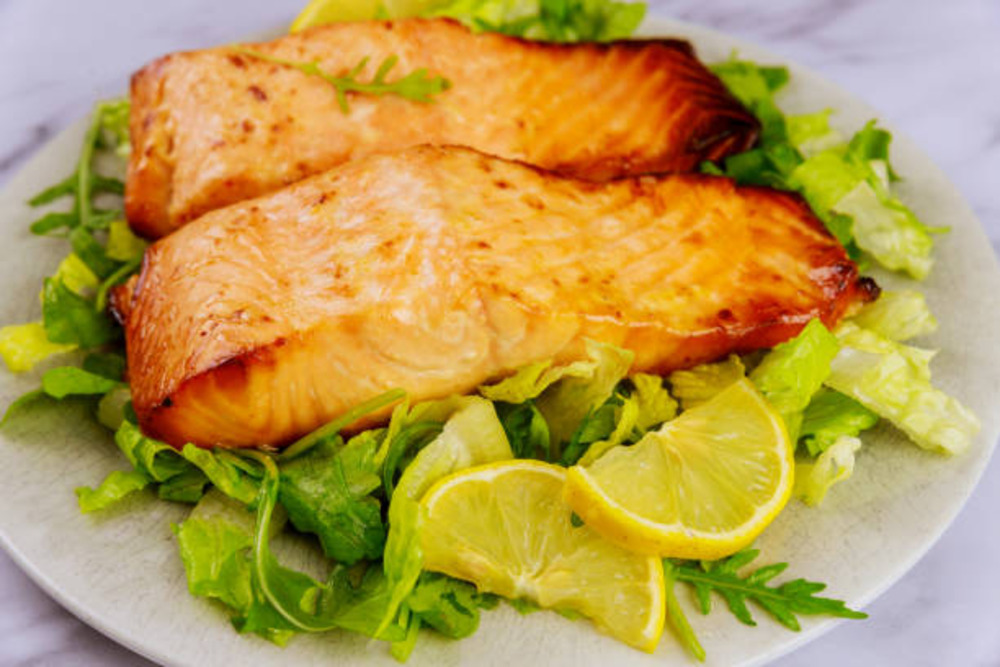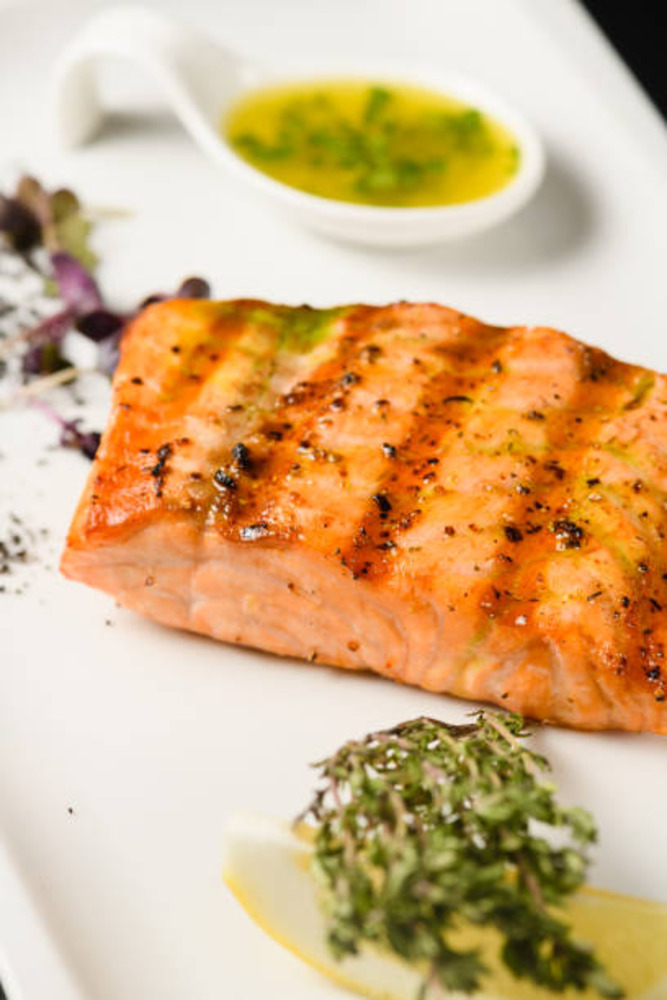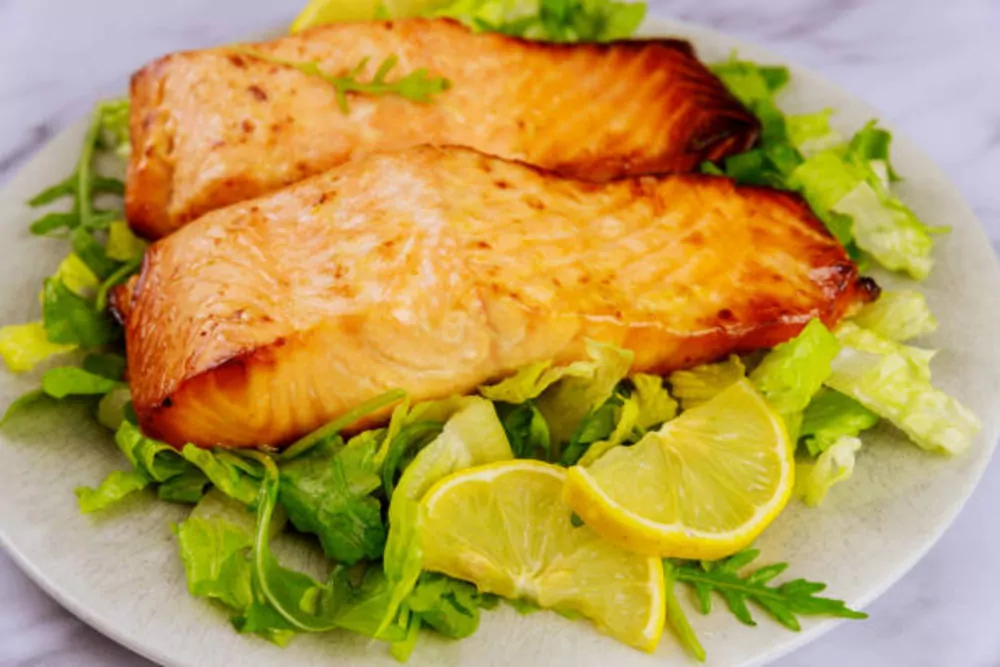Air fryer salmon is a delightful, healthy dish that combines the succulent flavors of fresh salmon with the convenience and efficiency of air frying. This method ensures a perfectly cooked, moist, and flavorful meal in minutes. The ease of preparation and cleanup makes it an excellent choice for both weeknight dinners and special occasions. Whether you’re a seasoned cook or a kitchen novice, this recipe promises to deliver a restaurant-quality meal with minimal effort.

Ingredients and Preparation
For this recipe, you’ll need two salmon fillets, each approximately six ounces. A pinch of kosher salt and black pepper will enhance the natural flavors of the fish. The marinade, made with one tablespoon each of Dijon mustard and brown sugar (or honey), half a tablespoon each of low sodium soy sauce and extra virgin olive oil, a quarter teaspoon of garlic powder, and an optional pinch of ground ginger, adds a deliciously complex taste. These ingredients work together to create a savory, slightly sweet glaze that complements the richness of the salmon.
Before you start cooking, gather the necessary tools: an air fryer, aluminum foil for easy cleanup, a small bowl or liquid measuring cup for mixing the marinade, and paper towels for drying the salmon. Ensure your air fryer is in good working condition and preheat it to 400 degrees Fahrenheit, which usually takes about three minutes.
Pat the salmon fillets dry with paper towels, ensuring a crispy exterior when cooked. Lightly season both sides with kosher salt and black pepper, enhancing the fish’s natural flavors.
Step-by-Step Cooking Instructions
First, mix the marinade ingredients in a small bowl or liquid measuring cup. Combine the Dijon mustard, brown sugar (or honey), soy sauce, olive oil, garlic powder, and ground ginger (if using) until well blended. Spoon this mixture generously over the top of the salmon fillets, ensuring each piece is well coated.
Line the air fryer basket with aluminum foil for easy cleanup and to prevent the salmon from sticking. Carefully place the seasoned fillets in the basket, ensuring they do not touch each other for even cooking.
Cook the salmon in the preheated air fryer for 6 to 11 minutes, depending on the thickness of the fillets and your specific air fryer model. Fillets around one inch thick typically need about 8 to 9 minutes. To avoid overcooking, check the salmon’s internal temperature with an instant-read thermometer. The salmon is done when it reaches 145 degrees Fahrenheit. For optimal results, I suggest removing the salmon a few degrees early and letting it rest, allowing the residual heat to finish the cooking process.
Once cooked, transfer the salmon to a serving plate and enjoy it hot. An extra sprinkle of salt and pepper can be added if desired.
Recipe Tips & Frequently Asked Questions
Best practices for selecting fresh salmon: Choose fillets that are bright and firm with a fresh, mild smell.
Alternatives for key ingredients: If you don’t have Dijon mustard, whole grain mustard works well. Maple syrup can substitute for honey or brown sugar.
Tricks for ensuring even cooking in the air fryer: Avoid overcrowding the basket and ensure the fillets are of similar thickness.
Tips to avoid common mistakes: Preheat the air fryer and check the salmon’s temperature towards the end of the cooking time to prevent overcooking.
How to store and reheat leftovers: Store in an airtight container in the refrigerator for up to 3 days. Reheat gently in the air fryer or oven.
Can this recipe be made with frozen salmon? Yes, but thaw the fillets completely and pat them dry before seasoning.
Adjustments for different air fryer models: Cooking times may vary, so check the fillets’ internal temperature.
How to tell if the salmon is fully cooked: The salmon should flake easily with a fork and have an internal temperature of 145 degrees Fahrenheit.
What to Serve with This Recipe
This air fryer salmon pairs wonderfully with a variety of side dishes. Consider serving it with steamed vegetables, a fresh garden salad, or a hearty grain like quinoa or brown rice. For beverage pairings, a crisp white wine such as Sauvignon Blanc or a light, refreshing beer complements the dish well. Garnishes like fresh dill, lemon wedges, or a sprinkle of sesame seeds can add an extra touch of flavor and visual appeal.
Variations and Enhancements
Experiment with different seasoning blends to customize the flavor of your salmon. A mix of paprika, cumin, and chili powder can add a smoky, spicy kick. Adding vegetables to the air fryer, such as asparagus or Brussels sprouts, allows you to cook your entire meal in one go. For larger gatherings, scale up the recipe and cook in batches, keeping the cooked fillets warm in a low oven until ready to serve.
This air fryer salmon recipe is a fantastic addition to your culinary repertoire. Its simplicity and flavor make it a go-to meal for any occasion. We encourage you to try this recipe and experience the delicious results for yourself. Share your creations and feedback, and enjoy the convenience and taste of air fryer cooking.

Ingredients
- 2 salmon fillets (approximately 6 ounces each)
- Pinch of kosher salt
- Pinch of black pepper
- 1 tablespoon Dijon mustard
- 1 tablespoon brown sugar or honey
- ½ tablespoon low sodium soy sauce
- ½ tablespoon extra virgin olive oil
- ¼ teaspoon garlic powder
- Pinch of ground ginger (optional)
Instructions
Start by patting the salmon fillets dry with paper towels. Lightly season both sides with kosher salt and black pepper.
To make cleanup easier, line your air fryer basket with aluminum foil. Preheat your air fryer to 400 degrees F as per the manufacturer’s guidelines (for my air fryer, this takes about 3 minutes).
In a small bowl or a larger liquid measuring cup, combine the Dijon mustard, brown sugar (or honey), soy sauce, extra virgin olive oil, garlic powder, and ground ginger if using. Mix thoroughly until well blended. Spoon this mixture generously over the top of the salmon fillets.
Carefully slide out the air fryer basket and place it on a heatproof surface. Arrange the salmon fillets in the basket, ensuring they do not touch each other.
Cook the salmon in the air fryer for 6 to 11 minutes, depending on the thickness of the fillets and the specific model of your air fryer. Fillets that are around 1 inch thick typically need about 8 to 9 minutes. Avoid overcooking to prevent the salmon from drying out. The salmon is fully cooked when it reaches an internal temperature of 145 degrees F, measured with an instant-read thermometer. I prefer to remove the salmon a few degrees early and let it rest, allowing the residual heat to finish the cooking process. Check the salmon towards the end of the cooking time to ensure it doesn’t overcook.
Transfer the cooked salmon to a serving plate and enjoy it hot. Add an extra sprinkle of salt and pepper if desired.

Air Fryer Salmon Recipe
Ingredients
- Pinch of black pepper
- 1 tablespoon Dijon mustard
- 1 tablespoon brown sugar or honey
- ½ tablespoon low sodium soy sauce
- ½ tablespoon extra virgin olive oil
- ¼ teaspoon garlic powder
- Pinch of ground ginger optional
Instructions
- Start by patting the salmon fillets dry with paper towels. Lightly season both sides with kosher salt and black pepper.
- To make cleanup easier, line your air fryer basket with aluminum foil. Preheat your air fryer to 400 degrees F as per the manufacturer’s guidelines (for my air fryer, this takes about 3 minutes).
- In a small bowl or a larger liquid measuring cup, combine the Dijon mustard, brown sugar (or honey), soy sauce, extra virgin olive oil, garlic powder, and ground ginger if using. Mix thoroughly until well blended. Spoon this mixture generously over the top of the salmon fillets.
- Carefully slide out the air fryer basket and place it on a heatproof surface. Arrange the salmon fillets in the basket, ensuring they do not touch each other.
- Cook the salmon in the air fryer for 6 to 11 minutes, depending on the thickness of the fillets and the specific model of your air fryer. Fillets that are around 1 inch thick typically need about 8 to 9 minutes. Avoid overcooking to prevent the salmon from drying out. The salmon is fully cooked when it reaches an internal temperature of 145 degrees F, measured with an instant-read thermometer. I prefer to remove the salmon a few degrees early and let it rest, allowing the residual heat to finish the cooking process. Check the salmon towards the end of the cooking time to ensure it doesn’t overcook.
- Transfer the cooked salmon to a serving plate and enjoy it hot. Add an extra sprinkle of salt and pepper if desired.
Notes
TO REHEAT: Warm leftovers gently in a skillet on the stovetop over medium-low heat until just heated through.


